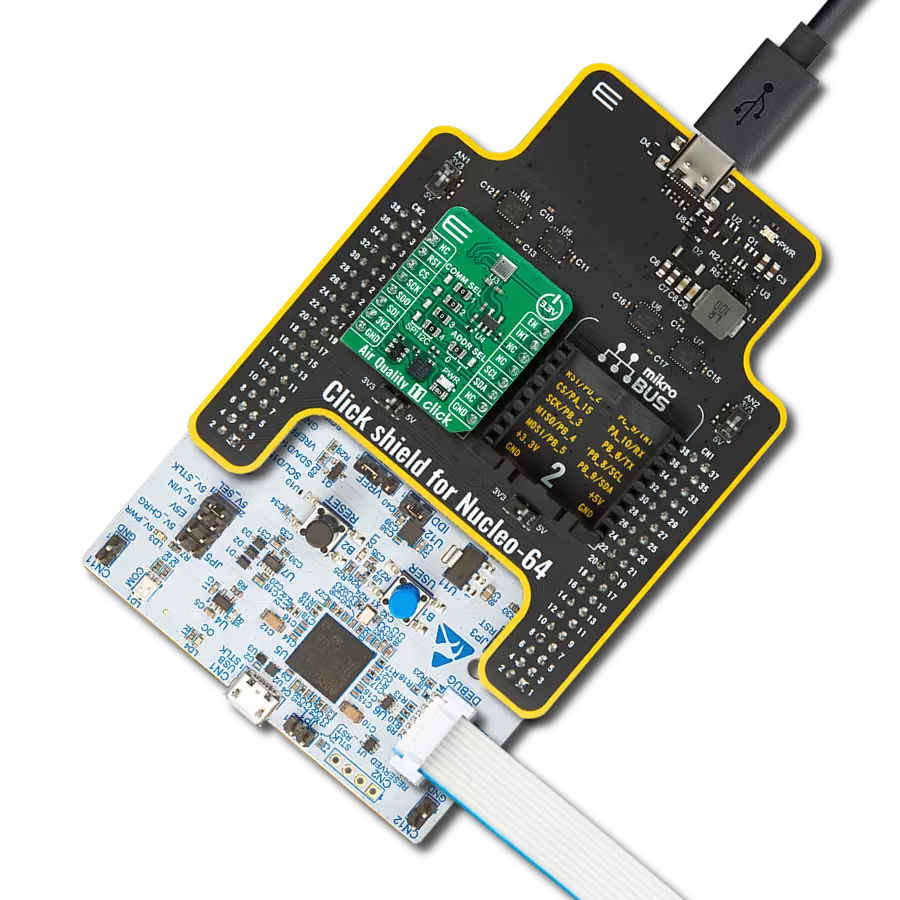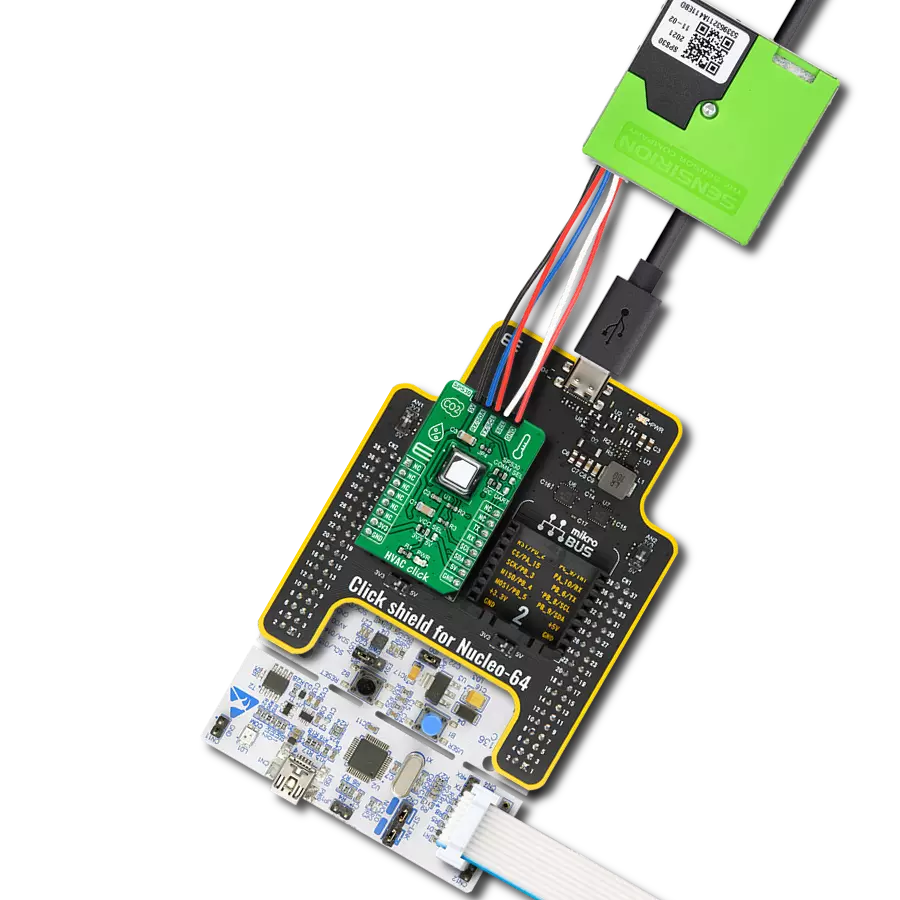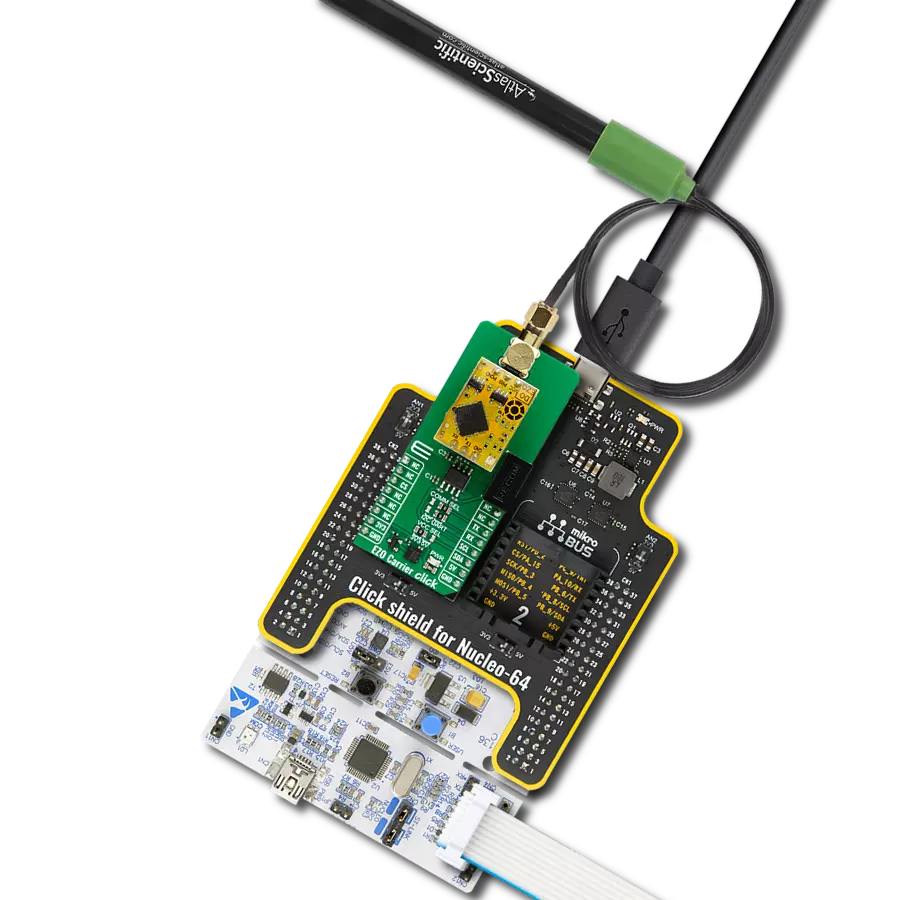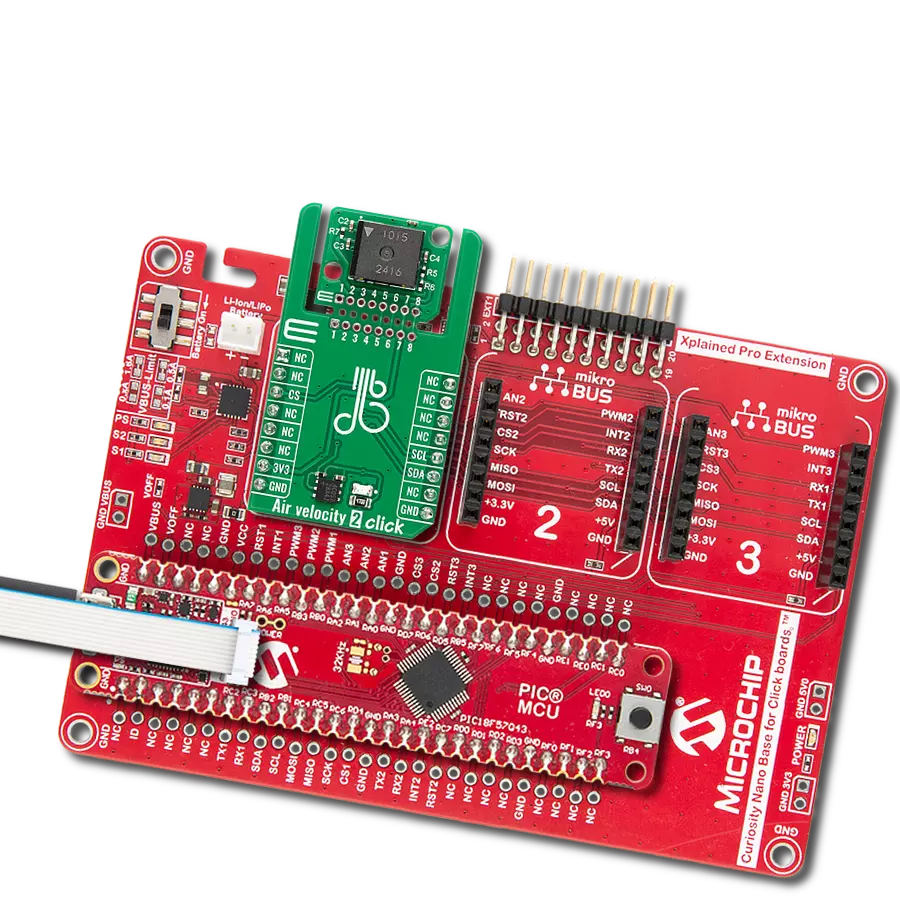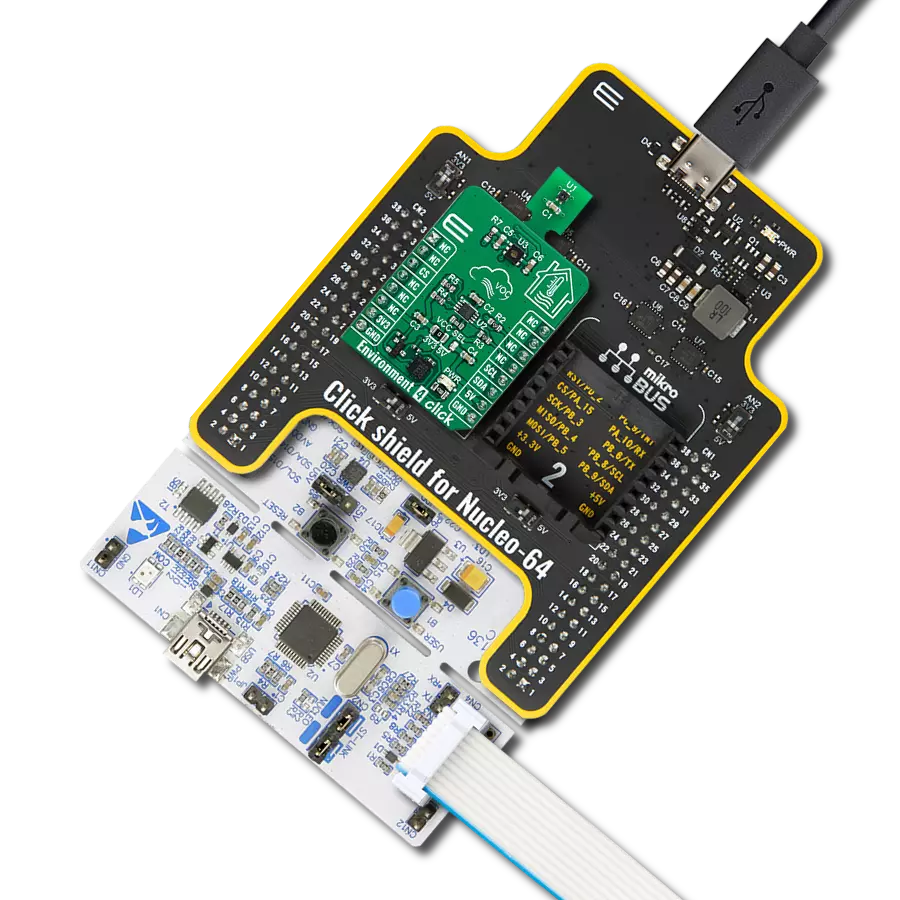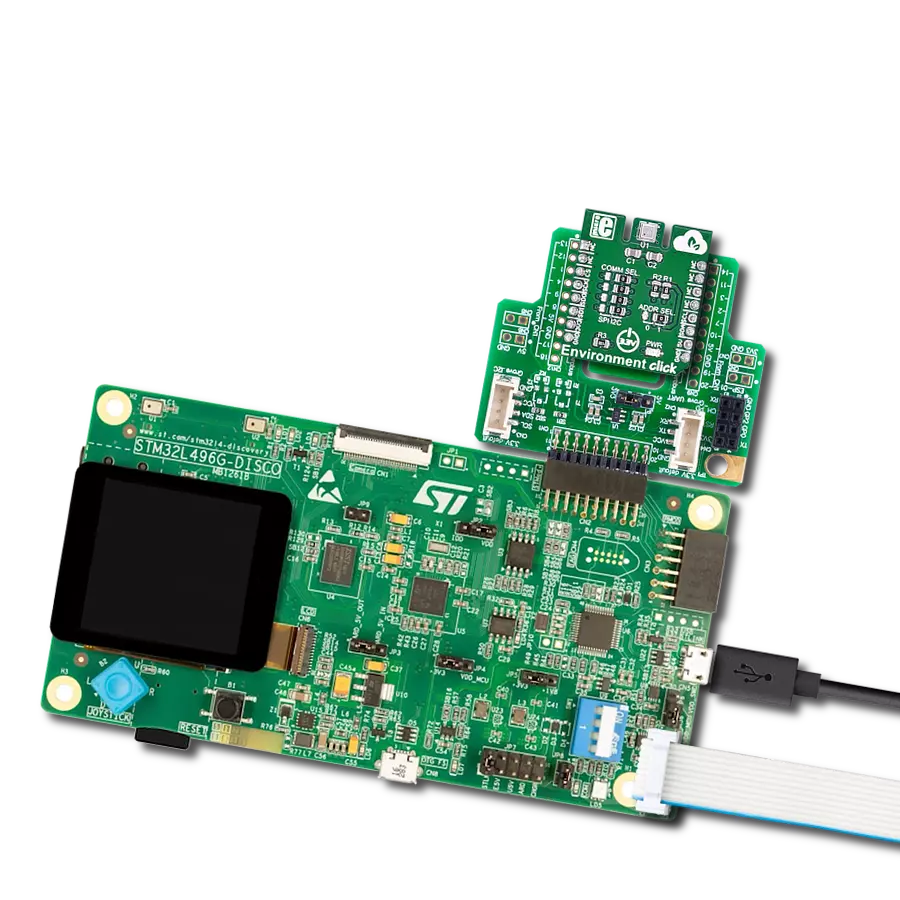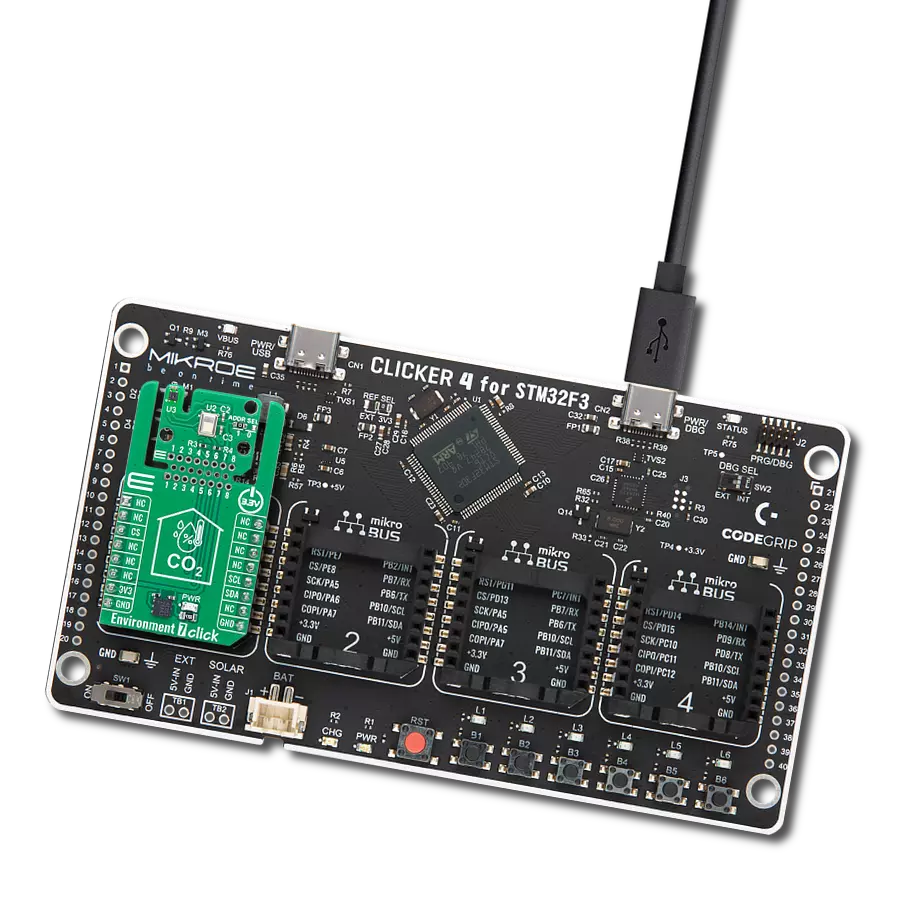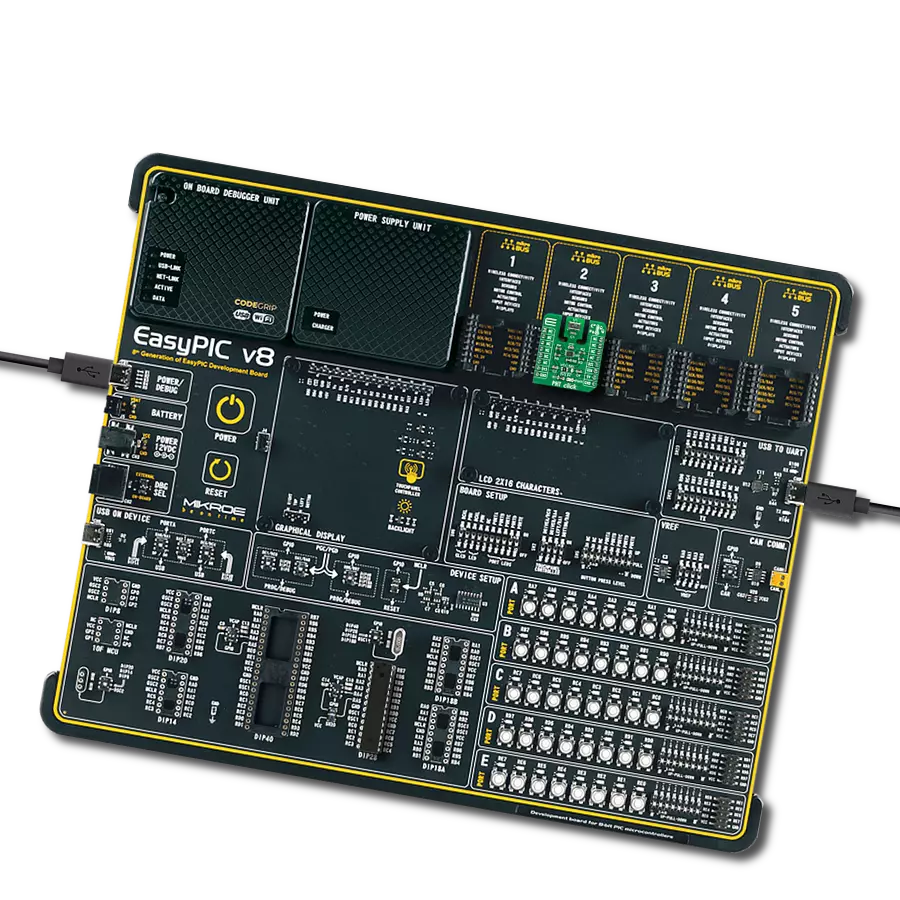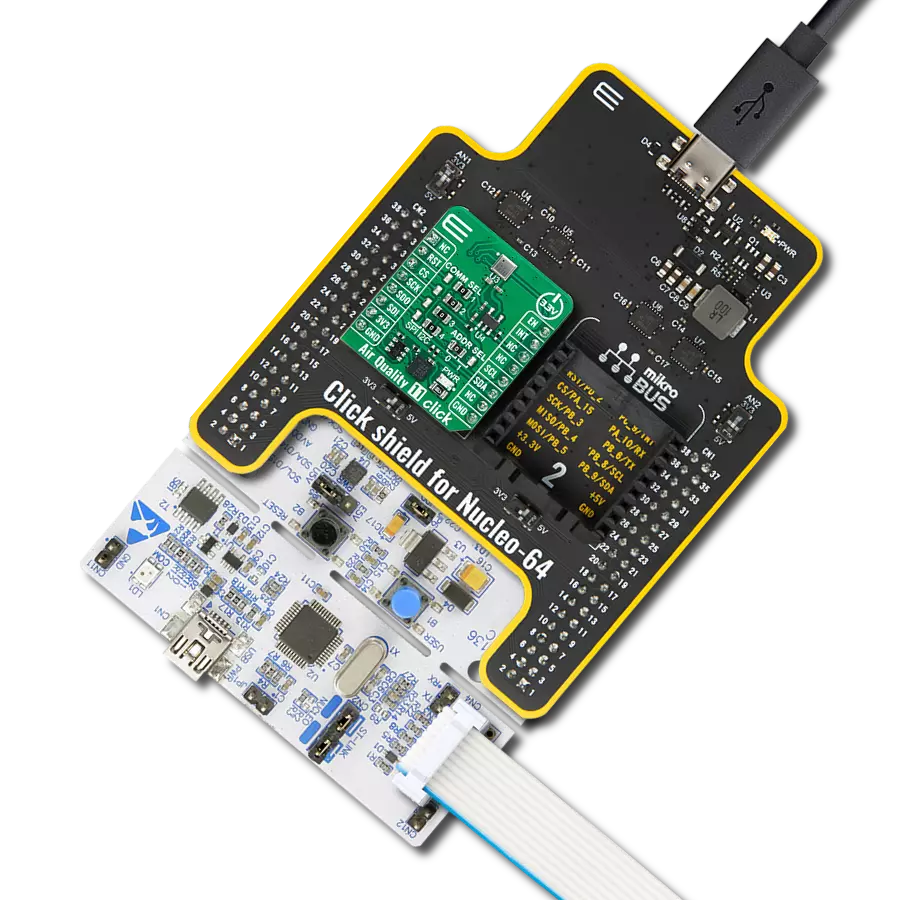With a solution like this one designed to determine the acidity or alkalinity of a sample, measured using the pH electrode, you can embark on various applications and activities across different industries and fields
A
A
Hardware Overview
How does it work?
pH 2 Click is based on the MCP607, a low-bias current operational amplifier from Microchip. This Click board™ operation is based on measuring hydrogen ion activity and produces an electrical potential or voltage. An electric potential develops when two liquids of different pH come into contact at opposite sides of a pH electrode thin glass membrane. The pH electrode represents a passive sensor, which means no excitation source (voltage or current) is required. It is classified as a bipolar sensor because its output can swing above and below the reference point. This board is a perfect solution for a wide variety of pH-sensing applications, including water treatment, chemical processing, medical instrumentation, and environmental test systems. pH 2 Click is used to detect the concentration of hydrogen ions in a solution and convert it into a corresponding
usable output signal. Because the pH electrode produces a bipolar signal, the electrode signal is first level shifted by the MCP607, a low bias current Op Amp set up in a unity-gain configuration with configurable reference for its calibration. Second, due to the high impedance of the electrode, another Op Amp inside the MCP607 provides the required high-input impedance buffer. A buffered signal can be then converted to a digital value using the MCP3221, a successive approximation A/D converter with a 12-bit resolution from Microchip using a 2-wire I2C compatible interface, or can be sent directly to an analog pin of the mikroBUS™ socket labeled as AN. The selection can be performed using an onboard SMD switch labeled OUT SEL, placing it in an appropriate position marked as AN or ADC. It is important to note that a pH electrode's sensitivity varies over
temperature. For this reason, it is possible to add the DS18B20, 1-wire thermometer via the DQ terminal to the pH 2 Click, whose temperature can be monitored via the DQ pin on the mikroBUS™ socket. In addition, the user can digitally monitor different statuses in operation through the ST1 and ST2 pins on the mikroBUS™ socket or through visual detection on the STAT1 and STAT2 LEDs. This Click board™ can operate with either 3.3V or 5V logic voltage levels selected via the VCC SEL jumper. This way, both 3.3V and 5V capable MCUs can use the communication lines properly. Also, this Click board™ comes equipped with a library containing easy-to-use functions and an example code that can be used, as a reference, for further development.
Features overview
Development board
PIC18F57Q43 Curiosity Nano evaluation kit is a cutting-edge hardware platform designed to evaluate microcontrollers within the PIC18-Q43 family. Central to its design is the inclusion of the powerful PIC18F57Q43 microcontroller (MCU), offering advanced functionalities and robust performance. Key features of this evaluation kit include a yellow user LED and a responsive
mechanical user switch, providing seamless interaction and testing. The provision for a 32.768kHz crystal footprint ensures precision timing capabilities. With an onboard debugger boasting a green power and status LED, programming and debugging become intuitive and efficient. Further enhancing its utility is the Virtual serial port (CDC) and a debug GPIO channel (DGI
GPIO), offering extensive connectivity options. Powered via USB, this kit boasts an adjustable target voltage feature facilitated by the MIC5353 LDO regulator, ensuring stable operation with an output voltage ranging from 1.8V to 5.1V, with a maximum output current of 500mA, subject to ambient temperature and voltage constraints.
Microcontroller Overview
MCU Card / MCU

Architecture
PIC
MCU Memory (KB)
128
Silicon Vendor
Microchip
Pin count
48
RAM (Bytes)
8196
You complete me!
Accessories
Curiosity Nano Base for Click boards is a versatile hardware extension platform created to streamline the integration between Curiosity Nano kits and extension boards, tailored explicitly for the mikroBUS™-standardized Click boards and Xplained Pro extension boards. This innovative base board (shield) offers seamless connectivity and expansion possibilities, simplifying experimentation and development. Key features include USB power compatibility from the Curiosity Nano kit, alongside an alternative external power input option for enhanced flexibility. The onboard Li-Ion/LiPo charger and management circuit ensure smooth operation for battery-powered applications, simplifying usage and management. Moreover, the base incorporates a fixed 3.3V PSU dedicated to target and mikroBUS™ power rails, alongside a fixed 5.0V boost converter catering to 5V power rails of mikroBUS™ sockets, providing stable power delivery for various connected devices.
This probe can be used with all pH meters with an input for the BNC connection with a 1m cable. The sensitive part of the probe (in the shape of a ball) is partially protected by a probe's plastic body, which reduces the possibility of mechanical damage. The EPH101 is used to measure the pH value of various liquids (due to the present plastic protection), and it can also be immersed in liquids inflowed in a system). It is stored in a plastic gel bottle with a very long shelf life. A pH (potential of Hydrogen) probe measures the hydrogen ion activity in a liquid. A membrane at the tip of a pH probe permits hydrogen ions from the liquid to be measured to defuse into the outer layer of the membrane while larger ions remain in the solution. The difference in the concentration of hydrogen ions outside the probe vs. inside the pH probe creates a small current proportional to the concentration of hydrogen ions in the measured liquid.
Used MCU Pins
mikroBUS™ mapper
Take a closer look
Click board™ Schematic

Step by step
Project assembly
Track your results in real time
Application Output
1. Application Output - In Debug mode, the 'Application Output' window enables real-time data monitoring, offering direct insight into execution results. Ensure proper data display by configuring the environment correctly using the provided tutorial.

2. UART Terminal - Use the UART Terminal to monitor data transmission via a USB to UART converter, allowing direct communication between the Click board™ and your development system. Configure the baud rate and other serial settings according to your project's requirements to ensure proper functionality. For step-by-step setup instructions, refer to the provided tutorial.

3. Plot Output - The Plot feature offers a powerful way to visualize real-time sensor data, enabling trend analysis, debugging, and comparison of multiple data points. To set it up correctly, follow the provided tutorial, which includes a step-by-step example of using the Plot feature to display Click board™ readings. To use the Plot feature in your code, use the function: plot(*insert_graph_name*, variable_name);. This is a general format, and it is up to the user to replace 'insert_graph_name' with the actual graph name and 'variable_name' with the parameter to be displayed.

Software Support
Library Description
This library contains API for pH 2 Click driver.
Key functions:
ph2_calibrate- Ph 2 calibrate functionph2_calculate_ph- Ph 2 calculate pH value functionph2_calibrate_offset- Ph 2 calibrate offset function
Open Source
Code example
The complete application code and a ready-to-use project are available through the NECTO Studio Package Manager for direct installation in the NECTO Studio. The application code can also be found on the MIKROE GitHub account.
/*!
* @file main.c
* @brief pH 2 Click Example.
*
* # Description
* This library contains API for pH 2 Click driver.
* The library initializes and defines the I2C bus drivers or
* ADC drivers to read data from pH probe.
*
* The demo application is composed of two sections :
*
* ## Application Init
* Initializes the driver and performs offset calibration,
* as well as calibration in pH-neutral substance.
*
* ## Application Task
* This example demonstrates the use of the pH 2 Click board by
* reading pH value of the substance where probe is placed.
*
* @author Stefan Ilic
*
*/
#include "board.h"
#include "log.h"
#include "ph2.h"
static ph2_t ph2; /**< pH 2 Click driver object. */
static log_t logger; /**< Logger object. */
void application_init ( void )
{
log_cfg_t log_cfg; /**< Logger config object. */
ph2_cfg_t ph2_cfg; /**< Click config object. */
/**
* Logger initialization.
* Default baud rate: 115200
* Default log level: LOG_LEVEL_DEBUG
* @note If USB_UART_RX and USB_UART_TX
* are defined as HAL_PIN_NC, you will
* need to define them manually for log to work.
* See @b LOG_MAP_USB_UART macro definition for detailed explanation.
*/
LOG_MAP_USB_UART( log_cfg );
log_init( &logger, &log_cfg );
log_info( &logger, " Application Init " );
// Click initialization.
ph2_cfg_setup( &ph2_cfg );
PH2_MAP_MIKROBUS( ph2_cfg, MIKROBUS_1 );
err_t init_flag = ph2_init( &ph2, &ph2_cfg );
if ( ( ADC_ERROR == init_flag ) || ( I2C_MASTER_ERROR == init_flag ) )
{
log_error( &logger, " Communication init." );
for ( ; ; );
}
log_printf( &logger, " ================================ \r\n" );
log_printf( &logger, " Performing calibration \r\n" );
log_printf( &logger, " ================================ \r\n" );
log_printf( &logger, " Disconect BNC connector, \r\n" );
log_printf( &logger, " short-circuit it, \r\n" );
log_printf( &logger, " adjust offset potentiometer \r\n" );
log_printf( &logger, " ================================ \r\n" );
log_printf( &logger, " STAT1 - turn clockwise \r\n" );
log_printf( &logger, " STAT2 - turn counter-clockwise \r\n" );
log_printf( &logger, " ================================ \r\n" );
ph2_calibrate_offset( &ph2 );
log_printf( &logger, " Calibration completed \r\n" );
log_printf( &logger, " ================================ \r\n" );
log_printf( &logger, " Connect probe back \r\n" );
log_printf( &logger, " ================================ \r\n" );
Delay_ms ( 1000 );
Delay_ms ( 1000 );
Delay_ms ( 1000 );
Delay_ms ( 1000 );
Delay_ms ( 1000 );
log_printf( &logger, " Place probe into pH \r\n" );
log_printf( &logger, " neutral substance for \r\n" );
log_printf( &logger, " mid point calibration \r\n" );
log_printf( &logger, " ================================ \r\n" );
Delay_ms ( 1000 );
Delay_ms ( 1000 );
Delay_ms ( 1000 );
Delay_ms ( 1000 );
Delay_ms ( 1000 );
log_printf( &logger, " Starting calibration \r\n" );
log_printf( &logger, " ================================ \r\n" );
ph2_calibrate( &ph2, 7 );
log_printf( &logger, " Calibration done! \r\n" );
log_printf( &logger, " ================================ \r\n" );
log_info( &logger, " Application Task " );
log_printf( &logger, " ================================ \r\n" );
}
void application_task ( void )
{
float pH_val = 0;
ph2_calculate_ph( &ph2, &pH_val );
log_printf( &logger, " pH value: %.3f \r\n", pH_val );
log_printf( &logger, " ================================ \r\n" );
Delay_ms ( 1000 );
}
int main ( void )
{
/* Do not remove this line or clock might not be set correctly. */
#ifdef PREINIT_SUPPORTED
preinit();
#endif
application_init( );
for ( ; ; )
{
application_task( );
}
return 0;
}
// ------------------------------------------------------------------------ END
Additional Support
Resources
Category:Environmental





















